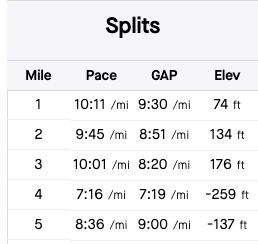Climbing hills makes running harder. For many folks who live in hilly areas this can make it difficult to compare training times. What happens when you run all your training miles on moderate hills but are entered in a pancake flat half marathon or marathon? And what about if you live on the plains but want to train for a mountainous trail run? For this having some normalizing metric to understand how your pace translates would be helpful.
If you have spent any time logging workouts in Strava and reviewing them, you have likely come across one metric that can be a bit confusing (or motivating)… GAP or Grade Adjusted Pace. This might be just what you need to help solve the previous problems, but GAP does have shortcomings.
This article covers what you need to know about GAP, and how much weight to put into it when reviewing. GAP is popularized by both Garmin, which reports GAP, as well as Strava which is the leader in popularizing the metric thanks to their more than 100 million users.
What does GAP mean On Strava?
GAP is an acronym for Grade Adjusted Pace. It considers for you the fact that running on a flat surface is not the same as running on hilly terrain or a steep downhill.
GAP is independent of other metrics and for the most part does not effect your stats. Things like the relative effort and fitness scores do not take into account the GAP, while they are likely linked. The linking is more often due to heart rate changes, where generally a steeper incline will result in higher heart rate and a relatively lower adjusted pace.
Segment times are also not effected by GAP. GAP is displayed for each segment, but the leaderboards only include a real pace not a GAP pace since they would still result in the same order since the calculation adjustment would be the same given that each runner is assumed to have run the same grade profile.
Pace Vs. Grade Adjusted Pace (GAP) on Strava
The main difference in Pace and GAP (Grade Adjusted Pace) on Strava is not only how they are calculated, but also how they are displayed. By default Pace is the primary speed metric shown in activity summaries. GAP is a deeper metric that is reported only on portions of a running activities, and not for cycling. Cycling activities have speed, but no grade based speed unless you use additional add-ons.

By default the GAP is reported for each mile and shown alongside the Pace of that same mile. If you want to know what the average GAP is on Strava, there is no easy way to capture this. GAP is not reported on a complete activity level (only on a per mile basis). Some of the popular strava add-ons do have ways of showing average GAP, but it is buried away in things like Elevate.
Will Strava consider GAP for Calculating a Personal Best?
No, Strava does not correct for GAP when calculating. If you run a blistering downhill mile in under 5 minutes, then it will show up as your personal best.
On the flip side, if you run your absolute best time in GAP but on an uphill segment where your actual pace was slower than the pace of your real PR then it will not be included in your PR chart. That is not to say that if you run a PR 5k on an uphill course it doesn’t count, just that the time to complete it will still be the PR not the GAP pace.
There is no way in the default Strava user interface to find your best GAP over any distance. Some of the top Strava add-ons do have the ability to make calculations like this if you are interested.
How is Grade Adjusted Pace calculated?
There is not a clean calculation to figure out GAP, it is modeled based on observations of existing Strava runs. It is based on an observed data from all of Strava’s input, and adjusted on a modeled basis according to their documentation. Their models are likely referred to as machine learning or AI, but are really best fit analysis based on more than 6 million observed workouts.
Some web forums of users own data suggest that a simple calculation of roughly 50ft of elevation changes the GAP by ~10 seconds. This should be noted though that it would only work for making adjustments at that one runners pace, since Strava has disclosed that their modeling takes into account the base pace of the run before making a modification. This means that GAP will adjust a pace more at a slower speed, and ultimately be more accurate (Strava GAP Blog post about the methodology).
Does Strava GAP Adjust for the Terrain?
The fact that the data is modeled would also suggest that GAP does take into consideration a bit of the terrain. Depending on the scope of the model, the GAP model should know if the training database is on a trail or a flat road and be able to adjust accordingly. In practice though we tend to see similar GAP to normal pace differences regardless of the surface that we ran on. That means that an uphill climb over loose rocks and sand would be adjusted at the same rate of a similarly steep uphill paved road.
1 thought on “Strava GAP – Grade Adjusted Pace”
Comments are closed.